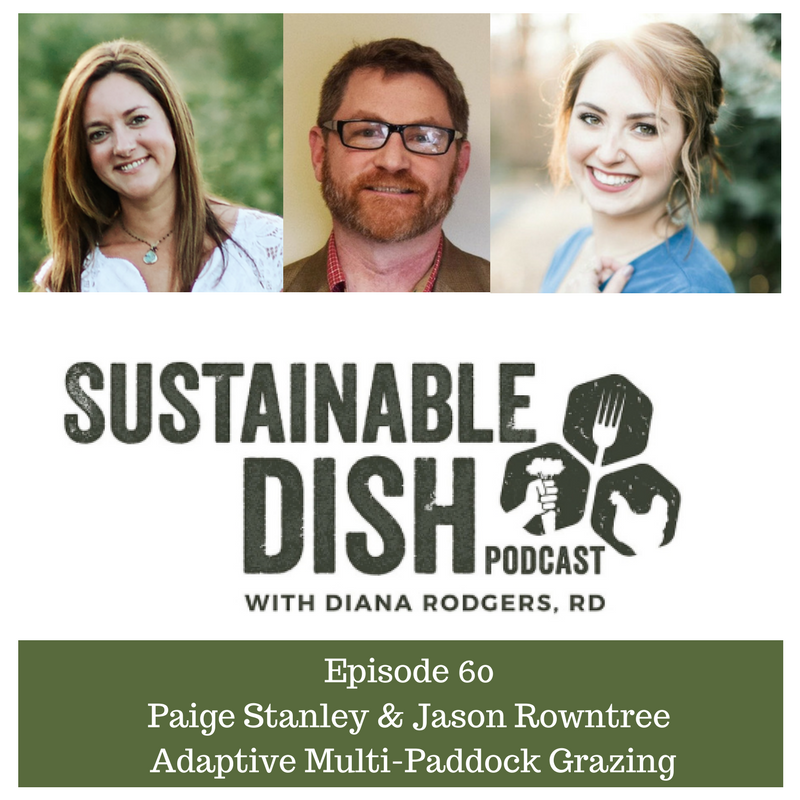
We hear it all the time – cattle are blamed for releasing tons of methane gas, which contributes to global warming. But is it all cattle, or is it the WAY cattle are managed on the land that’s the issue?
Some studies have looked at grass-fed beef and have found not only do the animals take up more land, but the greenhouse gas (GHG) emissions are EVEN WORSE than feed-lot finished beef. But again, do we really have the whole story? Is there more to it?
There’s been a growing movement of farmers and ranchers who have moved towards a “new” model of raising cattle. I say new in quotes because actually, the concept is based on the way herding animals have lived in nature forever. This method is called many different things: mob grazing, rotational grazing, adaptive multi-paddock (AMP) grazing, holistic planned management and intensive grazing. The basic idea is that you need to intensively graze the herd of ruminants (grass eaters like cattle, bison, sheep, etc) on a piece of land and then quickly move them, providing the optimal nutrition for the animals and allowing the land to rest and recover. There’s more to it than this, and there are different philosophies on how often to move the animals, but that’s the basic idea: “biomimicry” or trying to replicate natural cycles as much as possible.
In “continuous grazing,” when the cattle are left on the same field everyday, the animals can overgraze their favorite patches of grass, killing the plants and destroying soil. Their manure can become a problem, and the animals can easily pass parasites from one animal to the other because the life cycle of worms is never interrupted by time.
Think about herds of wildebeests in Africa. They can’t stay still continuously graze or else they’d get gobbled up by a lion. Herd animals need to clump together in a pack for protection, eat as much as they can when they have the time, and stay on the move due to the pressure of predators.

It’s the predators that are keeping the land from being overgrazed. Meanwhile, the hoof stomping of the large animals allows for better water penetration when the rains come. Their manure inoculates the soil with microbes, and their grazing (just enough, not too much) stimulates new growth in the grasses. After they move on, the land has a chance to rest and this is when the “regeneration” happens.
On ranches, we can mimic this same system. Instead of wildebeests, we can use cattle, sheep, goats or bison. Instead of predators, we can use electric fencing. Farmers can plot out how frequently to move the animals depending on stocking density, available acreage, pasture conditions, etc.

But proof has been hard to come by, and there are tons of skeptics out there claiming that grass-fed beef is still just a waste of land and emits too much methane.
A new study has just come out from Michigan State: Impacts of soil carbon sequestration on life cycle greenhouse gas emissions in Midwestern USA beef finishing systems was just published in Agricultural Systems. The researchers tracked carbon sequestration over four years. And although the feedlot system produced less emissions (in terms of cow farts,) when looking at the entire lifecycle system, cattle raised in the AMP management system produced a net carbon SINK. The emissions were completely offset by the amount of carbon sequestered in the ground. And not just a little bit of carbon, it was a significant amount.
Here’s an excerpt from the paper:
Across-farm soil organic carbon (SOC) data showed a 4-year C sequestration rate of 3.59 Mg C ha−1 yr−1in AMP grazed pastures. After including SOC in the GHG footprint estimates, finishing emissions from the AMP system were reduced from 9.62 to −6.65 kg CO2-e kg carcass weight (CW)−1, whereas feed-lot (FL) emissions increased slightly from 6.09 to 6.12 kg CO2-e kg CW−1 due to soil erosion. This indicates that AMP grazing has the potential to offset GHG emissions through soil C sequestration, and therefore the finishing phase could be a net C sink.
I recently invited the authors, Jason Rowntree and Paige Stanley, onto my podcast to discuss how they conducted the research and to further break it down for us lay people. You can listen to the show here. They also explain that although the feed-lot method of raising cattle does take up less land, most cattle are actually grazing on land that cannot be cropped. This fact, in addition to the concept that we need to be measuring more than just methane emissions, but the entire cycle, is critical to understanding the benefits of regenerative agriculture.
I’m so excited that more research is coming out about this! For the last 20 years or so, we’ve had tons of “before and after” images of the improvements to the land with better grazing techniques. Farmers have known that these methods produce healthier cattle and can regenerate soils, but now we’re actually starting to see proof through data collection.
I’m also looking forward to seeing more results coming from The Savory Institute through their new Ecological Outcome Verification (EOV) program that they’re launching with partners like Maple Hill Creamery, Epic, and Applegate (three companies I adore!). The EOV protocol monitors multiple key indicators of ecosystem health across the categories of soil health, water retention, and ecosystem function. Once positive outcomes have been established and trended over time, the participating farm or ranch receives Verification, which is reassessed for renewal annually. This is a really exciting time in the field of regenerative agriculture, and I’m thrilled to help get the word out!
Like what you’ve read? Want to learn more? I’ll be exploring the environmental benefits of cattle plus the nutritional and ethical considerations related to red meat in my new film, Kale vs. Cow. Learn more about it here!









10 thoughts on “It’s Not the COW, it’s the HOW: New Study Shows Grass-fed Beef Can be a Carbon Sink”
Keep up the good work Diana! I love listening to your podcast and have supported your project Kale vs Cow.
Thanks!
I was a little alarmed at first by your carbon sink article because the title came across as grass fed v.s. feedlot which I would want to stay away from since both are vital to America’s animal agriculture, but upon reading further I see that you are just debunking some misconceptions about grass fed beef. I am a cow/calf operator in Idaho and have been following you for a few months now and do thank you for your time and expertise. While I finish a few steers both grass and grain and both are very different. Even though my cows are purely fed grass and legumes and know first hand how important to the bottom line to have cheep grass at hand for my herd, I personally prefer grain finished. Anyway both my land and the public lands that my animals graze upon are not suitable for farming. Grazing animals on this land is beneficial and definitely not a waist.
It would be of interest to see a study which accounted for the fossil fuel inputs of deforestation of land necessary for growing crops, the fertiliser process and heavy industry needed to transport the feed. Further, the vegan argument that growing miles of soy crops is less harmful to the environment than cattle grazing deserves academic attention.
Yes! And I would like to know how reforesting these pasteurs would affect carbon sink.
Forests and grasslands are BOTH important ecosystems. There is great interest lately in silvopasture: pastures studded with trees, which off the top of my head seems to combine two great ideas. Permaculture teaches that the most dynamic ecosystems in terms of biodiversity are edge systems where one meets another, such as wetlands, a buffer between land and see, which supports some land species, some sea species, and some uniquely adapted to wetlands themselves. I imagine silvpasture has similar advantages and can support more wildlife species and also do well at sequestering carbon.
Not all pasture could be reforested, and we need to have grasslands as well as forest for the diversity they provide for wildlife. Grassland birds cannot live in a forest…
This makes for interesting reading. Definitely something I was not aware of. Keep up the good work!
Pingback: [BLOCKED BY STBV] Is a Meat Tax a Good Idea? - Sustainable Dish
Thank you for this great post — and clearing the air with the misperceptions about grass fed beef. We’re a family grass-fed beef producer and there is a lot of misinformation, especially by the ‘Big Beef’ producers, which are owned by international corporations (may are based in Brazil). We agree with Joe — Keep up the Great work on this important topic.
Chris Kovac